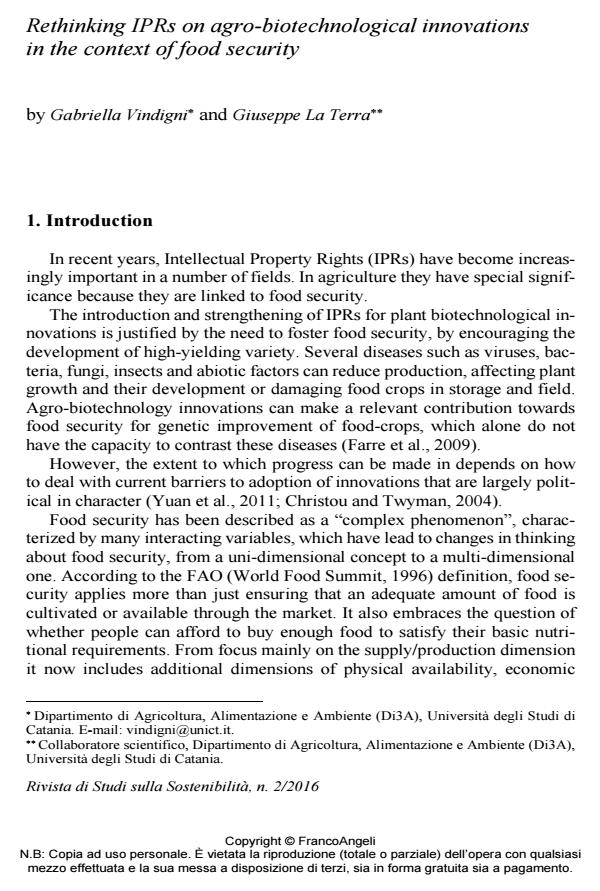Rethinking IPRs on agro-biotechnological innovations in the context of food security
Journal title RIVISTA DI STUDI SULLA SOSTENIBILITA'
Author/s Gabriella Vindigni, Giuseppe La Terra
Publishing Year 2017 Issue 2016/2 Language English
Pages 0 P. File size 142 KB
DOI 10.3280/RISS2016-002007
DOI is like a bar code for intellectual property: to have more infomation
click here
Below, you can see the article first page
If you want to buy this article in PDF format, you can do it, following the instructions to buy download credits

FrancoAngeli is member of Publishers International Linking Association, Inc (PILA), a not-for-profit association which run the CrossRef service enabling links to and from online scholarly content.
This paper engages in the debate on how agro-biotechnological innovations can influence food security. IPRs are considerate an important incentive for research initiatives based on genetic resources and they encourage investments in agricultural innovations. However, concerns have risen about the current system of IPR in plant improvement over its impact on food security. IPRs may affect the accessibility and availability of a large number of agricultural products, undermining food security.
Keywords: Food security, agro-biotechnology, access to food, Intellectual Property Rights, Plant Breeder Rights, farmers’ exemption.
- Barton J.H., Berger P. (2001). Patenting Agriculture. Issues in Science and Technology, 17, 4.
- Batur F., Dedeurwaerdere T. (2014). The use of agrobiodiversity for plant improvement and the intellectual property paradigm: institutional fit and legal tools for mass selection, conventional and molecular plant breeding. Life Science Social Policy, 10: 14.
- Bellia C., Bonfiglio G., Adernò C. (2015). Food poverty and solidarity networks in Italy. Rivista Studi Sulla Sostenibilità, 2: 95-112.
- Bellmann C., Melendez-Ortiz R. (2013). Trading in Knowledge: Development Perspectives on TRIPS, Trade and Sustainability. London: Routledge.
- Blakeney M. (2009). Intellectual Property Rights and Food Security. CABI
- Christou P., Twyman R.M. (2004). Potential of genetically engineered crops to address food insecurity. Nutrition Research Reviews, 17(1): 23-42.
- Cullet P. (2004). Food security and intellectual property rights in developing countries. Les Cahiers du RIBios, 6.
- Dutfield G. (2010). Intellectual Property, Biogenetic Resources and Traditional Knowledge. London: Routledge.
- FAO. (1996). Rome Declaration on World Food Security and World Food Summit Plan of Action. World Food Summit, 13-17 November 1996, Rome.
- FAO (2004). The state of food and agriculture 2003-2004. FAO Agriculture Series, 35.
- Farre G., Ramessar K., Twyman R.M., Capell T., Christou P. (2010). The humanitarian impact of plant biotechnology: recent break- throughs vs bottlenecks for adoption. Current Opinion Plant Biology, 13: 219-225.
- Haugen H.M., Muller M.R., Narasimhan S.M. (2011). Food security and intellectual property rights, Finding the linkages. In: Wong T., Dutfield G. (eds.). Intellectual Property and Human Development, pp. 103-131.
- Helfer L.R. (2004). Intellectual Property Rights in Plant Varieties: International Legal Regimes and Policy Options for National Governments. FAO Legal Papers, 31.
- James C. (2015). Global Status of Commercialized Biotech/GM Crops. ISAAA Brief, 51. ISAAA: Ithaca, NY.
- Murphy D. (2007). Plant Breeding and Biotechnology: Societal Context and the Future of Agriculture. New York: Cambridge University Press.
- Netnou-Nkoana N.C., Jaftha J.B., Dibiloane M.A., Eloff J. (2015). Understanding of the farmers’ privilege concept by smallholder farmers in South Africa. South Africa Journal Science, 111(1/2).
- OECD (2002). Genetic Inventions, Intellectual Property Rights and Licensing Practices Evidence and Policies: Evidence and Policies. OECD Publishing.
- Pingali P. L. (2012). Green Revolution: Impacts, limits, and the path ahead. Proceedings of the National Academy of Sciences of the United States of America, 109(31).
- Prosperi P., Allen T., Padilla M., Peri I., Cogill B. (2014). Sustainability and Food & Nutrition Security: A Vulnerability Assessment Framework for the Mediterranean Region. SAGE OPEN, 4: 1-13.
- Raney T., Pingali P. (2004). Private Research and Public Goods: Implications of Biotechnology for Biodiversity. FAO ESA Working Paper, No. 04-07.
- Tawfiq A., Rasha A. (2014). Plant Varieties Protection: Patent vs. UPOV. WIPO Academy, University of Turin and ITC-ILO – Master of Laws in IP – Research Papers Collection.
- Teng, P.P.S. and Escaler M. (2014). Food Security in Asia. Hofmeister W., Rueppel P., Wong J. (eds.). Food Security: The Role of Asia and Europe in Production, Trade and Regionalism, Brussels, Belgium: European Policy Centre, pp. 11-36.
- Timpanaro G., Scuderi A., Foti V.T., Lo Giudice V. (2015). The social relationships’ effectiveness of “agrisocial” farms: A model of sustainable local development. Rivista Studi Sulla Sostenibilità, 1: 99-116.
- Tripp R., Eaton D., Louwaars N. (2006). Intellectual Property Rights: Designing Regimes to Support Plant Breeding in Developing Countries. Agricultural and Rural Development Department Report, No. 35517-GLB, World Bank, Washington D.C.
- Trommetter M. (2008). Intellectual Property Rights in Agricultural and Agro-food Biotechnologies to 2030. OECD International Futures Programme.
- UNCTAD (2006). World Investment Report, United Nations publication.
- Winter L. (2010). Cultivating Farmers’ Rights: Reconciling Food Security, Indigenous Agriculture, and TRIPS. Vanderbilt Journal of Transnational Law, 43: 223-254.
- Yuan D., Bassie L., Sabalza M. (2011). The potential impact of plant biotechnology on the Millennium Development Goals. Plant Cell Reports, 30, 3: 249-265.
Gabriella Vindigni, Giuseppe La Terra, Rethinking IPRs on agro-biotechnological innovations in the context of food security in "RIVISTA DI STUDI SULLA SOSTENIBILITA'" 2/2016, pp , DOI: 10.3280/RISS2016-002007